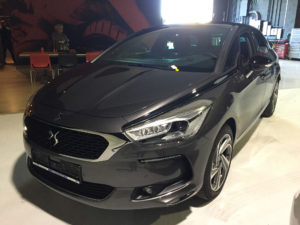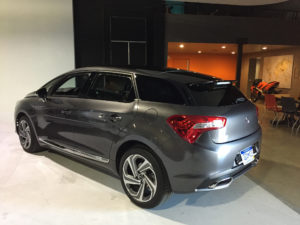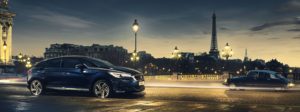by Richard Vaughan…..
From 1998 to January of this year, I was employed as a car designer for a US-based company that specialized in designing, engineering and manufacturing automotive interiors and electronics for global carmakers. It is a large multi-billion-dollar company with over 10,000 employees, but because it is business-to-business it is virtually unknown to consumers. Occasionally, we would have test vehicles and prototypes of unusual cars at our Detroit headquarters.
When I heard that we were getting a brand new Citroën DS5 for the office, I was fairly excited. There are only three new Citroën’s in North America. In addition to this DS5, there is a Cactus owned by Fiat Chrysler and PSA has a C4 in it’s US office in Southfield, Michigan.

 The DS5 in our Detroit studio photo shoot.
The DS5 in our Detroit studio photo shoot.
We got the car because we supplied Citroën with the instrument cluster and more importantly, the heads-up display. We were going to use the DS5 to market the display technology to GM, Ford and Fiat Chrysler. The head-up-display (HUD) was the lower cost and lower-tech implementation known as a “combiner HUD”. That means that it is not a virtual image that looks as if it is floating in above the hood. Rather, it is a projection on a clear piece of plastic that rotates to the deployed position on top of the instrument cluster binnacle. When people in the industry use the word “deployed” in this context, that means that the display surface is open or flipped up, as opposed to closed. These display surfaces can be stowed when not in use so that they are out-of-sight.
The so-called combiner HUD is a “cheap and cheerful” solution and after a few miles you forget about that piece of plastic and you just enjoy the convenience of the information being displayed in front of you. The images that can be displayed can be extremely simple, as in the case of the DS5, or they can get more complex. It all depends on the budget of the car company. Generally speaking, if the OEM wants a more sophisticated image, such as full color turn-by-turn navigation and other notifications, they will choose the more expensive windshield Hud solution as is seen in many cars today, from BMW to Cadillac, to Mercedes-Benz.
Citroën created the DS brand in 2009 to “express French style and luxury with beautiful details and exceptional quality”. Citroën intended the new brand to be more than what people have come to expect from Citroëns, to appeal to a premium European consumer, but is not plush enough to part of the European luxury segment, where cars such as the S-Class and 7-Series reside. It is also an ideal product for the growing China market, where Citroën has found some degree of success, but only in the lower priced segments.
Everyone in this Club knows what a technological and stylistic trailblazer the first Citroën DS was. This car most certainly does not live up to that famous model in terms of style and innovation, yet it’s a very interesting offering in a world of look-alike hatchbacks and feel-alike German sedans.
The DS5 is packaged unlike any other car on the road. It has a footprint that is somewhere between a VW Golf and a Ford Fusion. It’s tall but not as tall as an SUV. In Citroën tradition, the wheelbase is very long, but the overall length is not. All of this makes it unique. Even so, driving it around the streets of car-conscious Detroit, virtually nobody notices it.
As ho-hum as the exterior styling is, there is a sense of high design inside, especially in the details, that traditional cars from other brands simply cannot deliver.
The DS5 is one of only a handful of affordable cars where aesthetic inventiveness has clearly been consciously encouraged, and seemingly without usual financial constraints seen in the auto industry.
It’s chock full of thoughtful and beautifully designed details, expensive features and clever material juxtapositions, but the most satisfying impression it conveys is the abiding notion that someone actually took the time to conceive and craft each part. Everything, from the gear selector to the electric window switches, is a pleasure to look at and use. The leather seats are particularly stunning and beautifully executed in a way that isn’t seen on any other car south of a Bentley Mulsanne.
This particular example was powered by the 178bhp 2.0 HDi engine. It moves the car along just fine, but the “start/stop” technology is somewhat annoying. (This is a now commonplace system that automatically shuts the car off as soon as you stop and restarts it as soon as you lift your foot from the brake pedal). Other than that, there isn’t much to fault in the drivetrain department.
Sadly, the car has a fairly mediocre ride that isn’t in the same universe as its 1956 namesake, but we all know that conventional suspension technology can never deliver the ride you experience when riding on a cushion of nitrogen.
I was able to use the car extensively and eventually did the art direction for a series of corporate promotional shots. The interior images were created piece by piece. First, we shot the interior, then we shot the model, then we composed a background. It looks as if we photographed a woman driving though Paris, but it was all created in a computer in Michigan.
Being the manager of design and innovation, I had almost unlimited access to the car and I could drive it as much as I wanted to as long as I could conjure some plausible excuse, such as showing it to customers. In Detroit, everybody is a customer of some sort, so the DS5 made a few appearances at Cars & Coffee events. As enticing as it might seem to have access to all kinds of interesting cars, I never wanted to abuse my privileges with them because you don’t want to be the one who has to report that it was damaged in some way.
As a major supplier, we had the car in the US on “manufacturer plates” and we were free to drive those cars in any circumstances. However, eventually all non-conforming cars must be either shipped out of the country or crushed. Our policy is to ship them back, but we have a parking area behind our building where some pretty amazing US-spec test cars are slowly returning to the earth, including a 2014 Range Rover Sport with the supercharged engine and almost no miles.
A few years ago I walked through that parking area and noted a 2004 Ford Explorer with about 2500 miles on it that had sat for so long that the paint had fallen off of it. There was also a 1998 Lincoln Navigator that has sunken into the asphalt up to the wheels. I designed that car (interior and exterior) and it was a great reminder not to let my ego get out of control because what seemed so important once would eventually end up in the junk pile just like any other disposable product.





I owned a DS5 in New Zealand. I loved it. Mine was a 2L Turbo. It shot up the hills to my home. I miss it!